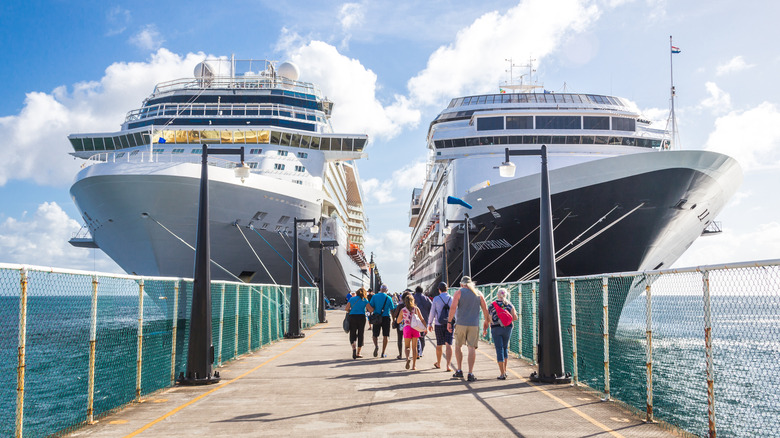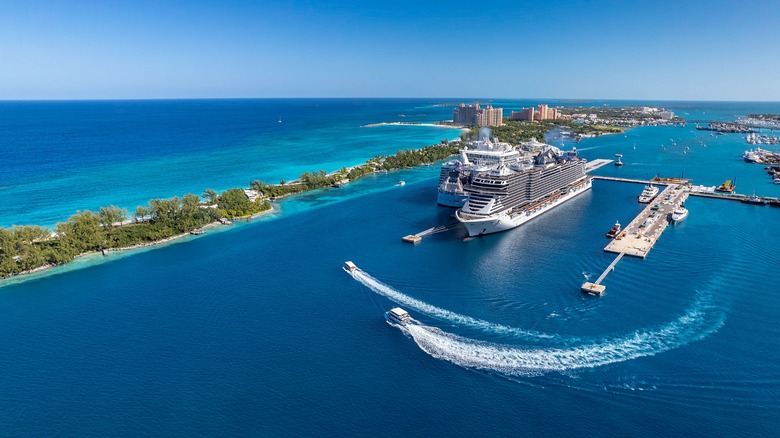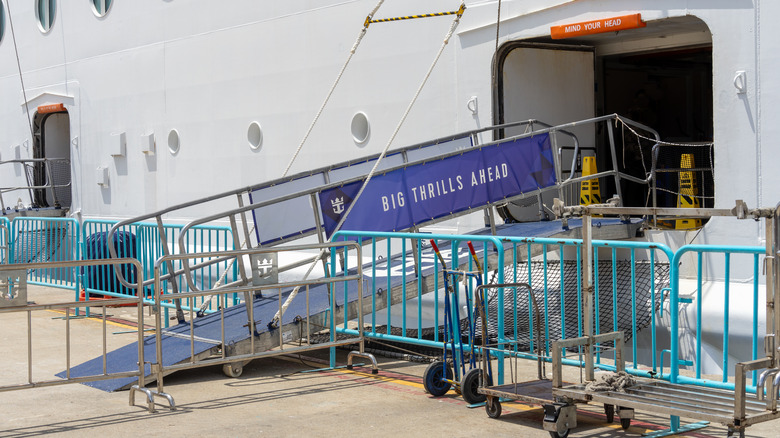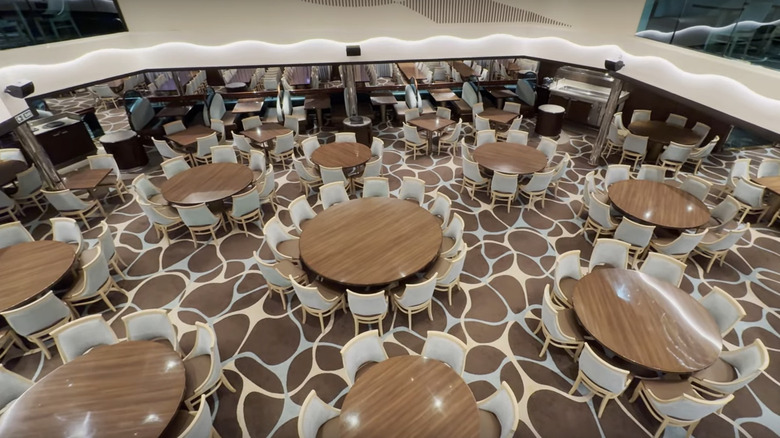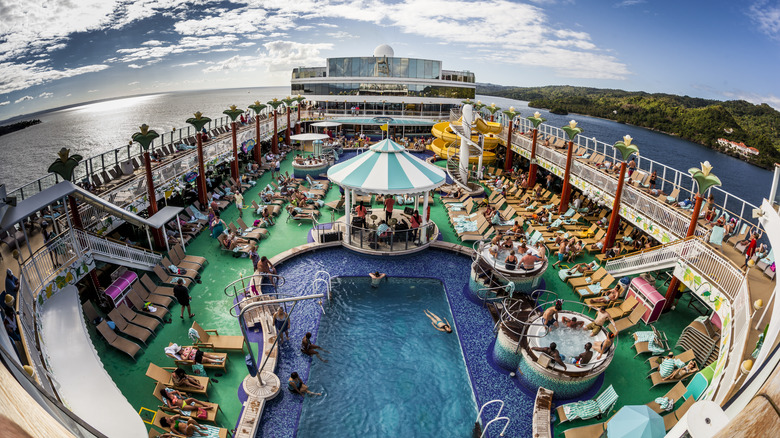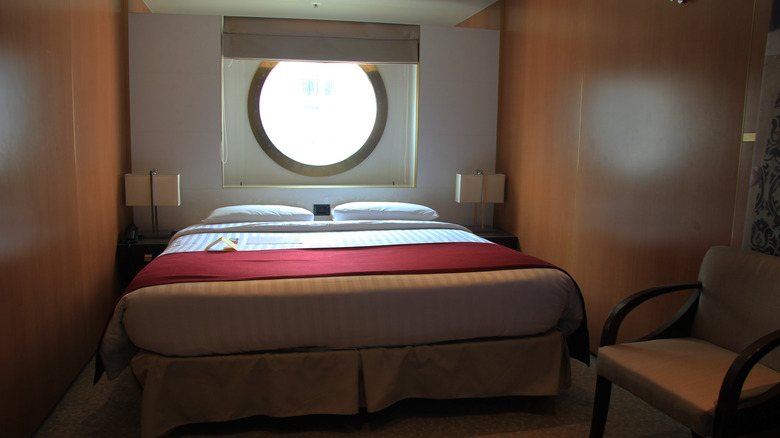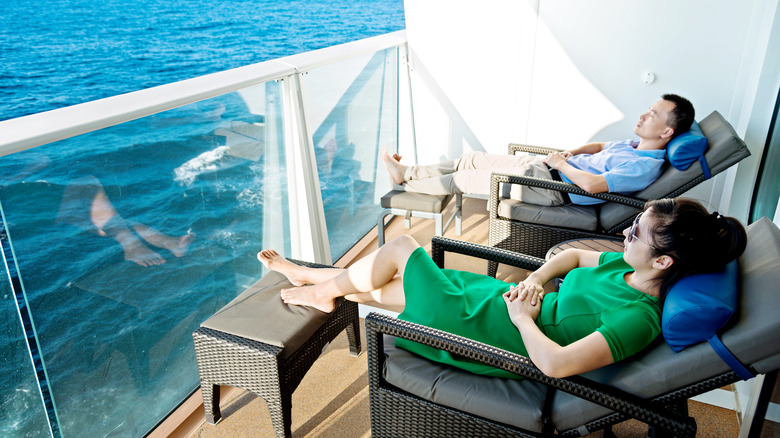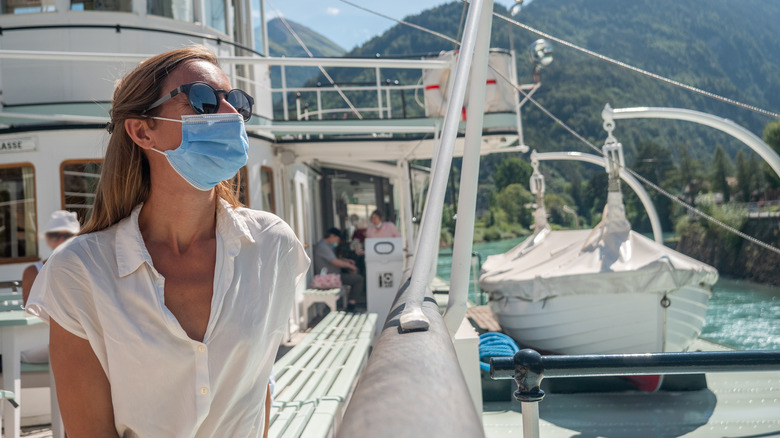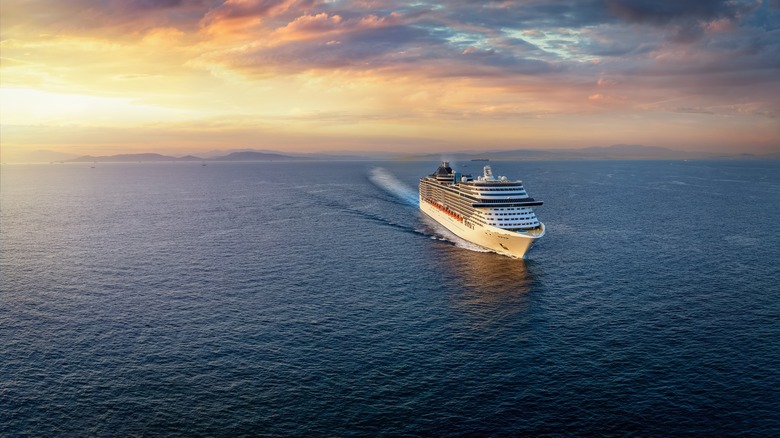Unsettling Reasons You May Want To Avoid Taking A Cruise
Featuring sunny images in most of their marketing collateral, cruises pitch themselves as breezy, carefree, and romantic ways to see all corners of the world. With the wind in your hair and the planet's landscapes and cities shuffling by in a never-ending montage of the globe's greatest hits, a cruise claims to transport you conveniently and cost-effectively. Cruise travelers can wind around the Caribbean, sail along slender rivers in Europe, and witness the grand glaciers of Alaska, all from the comfort of their room.
With some taking place aboard small and intimate ships and others akin to floating cities, cruises have caught on. More than 30 million passengers were forecast to sail the seas in 2023, according to the Cruise Line International Association (CLIA). But cruising isn't everyone's cup of tea, and for some travelers, it's a form of purgatory, a profoundly superficial medium of travel disconnected from the places it visits. For the many reasons that people can't get enough of cruises, there are many more reasons why they might prefer not to take one.
The itinerary can be underwhelming
Setting a cruise ship's specific journey is a complicated logistical minefield, and vessels travel on established routes compiled months or years ahead. What this might mean, in realistic terms, is that they won't stop at precisely the places that you want to go but instead visit the destinations that match the needs of the ship. Passengers who aren't 100% okay with the itinerary will have no choice but to compromise.
A five-day Caribbean cruise, for instance, might depart from southern Florida and head out for brief stops in the Bahamas and Mexico before returning to its point of origin. For much of that time, the ship will remain at sea, not letting passengers experience a destination. If you want to explore the world, don't take a cruise. If you are happy spending sizable chunks of your vacation trawling the ocean, then, by all means, book a trip on a ship.
Getting to the cruise is often inconvenient
A big selling point of cruises, especially for that select group of travelers that view cruising as a Neo-religion, is that you only have to pack twice (before boarding and when it's time to depart) and unpack twice (when you first board the ship and when you get home). This benefit remains even as see multiple destinations and experience the various cultures and wonders of places along the way. While this certainly is handy, cruising often comes with major inconveniences that may cause the ease of packing to lose some of its luster.
Unless you happen to live in or close to a major cruise port, there is a reasonable probability that you will have to take a flight to the cruise departure city and, after the trip, a flight back home. This adds another element to the journey, not to mention additional cost, the need for time management, and the added stress of potentially missing a connection — either the cruise departure at the beginning or the flight after you return from sailing. This doesn't seem like a particularly pleasant addendum to the vacation, does it?
You can only leave the ship at ports
Read between the lines that you will only need to unpack and pack twice, and you'll realize that you don't really leave the ship most of the time. It's your home, hotel, restaurant, entertainment, and place to decompress. You are stuck on the vessel, and the idea of it being a floating idyll on the high seas can quickly turn to images of a waterborne prison of sorts, from which there is no escape (of course, that is a slightly unfair analogy, since passengers chose to take the cruise, but you get our point).
The onboard experiences might be tremendous and wonderfully enjoyable with just the right mix of people, activities, and downtime. But what if you don't like the other people on the ship? What if there is tension between certain groups of passengers, among the crew, or, worse still, between you and someone else on board? In a town or city, you could disappear into anonymity and find numerous places to escape those bad vibes, but on a ship, your choices are limited since everyone circulates in the same set of spaces. Furthermore, cruise ships strive to maximize the number of passengers they can fit into their finite spaces, so crowds, especially on the larger vessels, are a given, and you won't be able to avoid them. Where's the fun in that?
The food is unlikely to have you cooing in appreciation
Let's be brutally honest: The food on these ships is designed for mass consumption — some ships have space for more than 5,000 passengers, after all — because large-scale meal production is the only practical and logistically feasible way to feed everyone on board. Given that, consistently good food is impossible to guarantee, and it's not hard to find cruise forum boards where posters bemoan the uninspiring quality of the grub onboard.
Ships have ample storage and galley facilities for their produce, meat, seafood, etc.; usually, at every port, they will re-stock the kitchen as comprehensively as possible. But this leaves them vulnerable to supply chain issues and inconsistent product quality, which has a knock-on effect on the dishes served onboard. Menus also tend to be simple, and buffets (never renowned for their haute cuisine) were a staple on cruises, though, since COVID-19, this has become less prevalent. Smaller ships can offer passengers a better, more varied selection of dishes, but the smaller the ship, the higher the cost of sailing.
The ports don't give you an authentic experience
Cruise ships spend a large portion of their time sailing between ports, though smaller river boats that cruise around Europe, for example, do allow passengers more time in each location. The problem with this is that, although you may cruise to your dream island, ships don't spend vast amounts of time at a locale — a full day, from early morning to late evening, usually is as much as you will get — and the ports where they dock tend to be very commercial, with cruise passengers viewed as little more than walking dollar signs.
For a cruiser, this means that the shopping by the ship tends to be tacky and geared toward giant hordes looking for something quick and easy as a souvenir (these items are usually overpriced), and the lack of time in port means that a passenger doesn't even get to scratch the surface of the place. If you really want to get a feel for Mexico, for instance, don't take a cruise that makes day stops in Cancún, Cozumel, or Puerto Vallarta, but book a land-based trip to the destination you want to explore.
The vessels are gaudy
We're not sure who first decided that the interiors of a cruise ship had to have over-the-top, bright colors and patterning, but the memo certainly stuck. While some passengers might declare that cruise ships have a sense of panache, others will say that they are gaudy, especially the larger ones. You're likely to see glitzy chandeliers that might blind you, jazzy carpeting that could make your head spin, and decor that espouses shock and awe as a mantra instead of simple and serene.
Cruise ships are also bad for the environment, even as the industry tries to address this historically undesirable aspect of its operations (via Mongabay). Wastewater is sometimes dumped into the sea. They are notorious emitters of pollution into the air because of the fuel they use, and they bring millions of passengers to destinations, either on land or in the water, that are already fragile.
Your choices of what to do are limited
As ships get bigger and more technologically advanced, and the facilities improve and expand, a sort of amenity creep appears, where companies try to outdo one another with unique cruise ship attractions to draw in customers. While, not many years ago, a live theatrical show, a dip in a top-deck pool, and maybe some slot machines were about as exciting as it got on a ship, today, passengers will find vessels where they can get on a surf or skydiving simulator, twist and turn in multiple waterslides, fly through the air on a zip line, or watch a movie in a 4D cinema.
"Wow," you might think, until you realize that these experiences get old quickly. You can find a new park or wander around a different part of the city on land, but how many times can you ride the same slide and still find it exciting? Plus, you'll be vying for the same amenities and facilities as thousands of other passengers, and the interminable lines for them might take the fun out of the experience, making it difficult to get the most out of your cruise.
Some cruises are famous for their partying
The imagery pushed by cruise companies does a smart job of promoting liberating sea and scenery, the feeling of fresh air, the places you'll see, and the landscapes and cities close enough to touch. They don't show drunken revelers wobbling along the pool deck, trying to remain upright as they head back to their cabin, or crashed-out passengers at their seats by the bar after they'd had five drinks too many.
It's not an unreasonable assumption to think that many people cruise to enjoy the water and the destinations. Still, some ships are known as places where passengers come primarily to drink, get wild, and behave in ways they never would back home. Many of these types of cruises will be short sailings, often taking place over a weekend, and sometimes going to no particular destination — cruises to nowhere, as they are known in the industry — letting the ship become a floating frat party waiting to happen.
You can't really enjoy your room
One of the great things about a good hotel room, or spacious vacation rental, is the sense of comfort and confinement it offers, a place where you can shut the door and unwind. Maybe you can slide onto a deep couch and snuggle under a fuzzy blanket or lay back on a firm bed with improbably soft sheets and flick through the channels on the large flat-screen TV. Alternatively, you could sip a warm drink and look out the window to gaze over the city, mountains, and the sea.
On ships, such scenarios will be far removed because the cabins tend to be small and cramped and are not ideal places for taking a break. Some of them, known as inside cabins because they are on the inside of the vessel, don't even have a window and feel like soul-less boxes where you have been banished to disappear from the world. There are spacious suites that offer a sense of escape, but for the average passenger, the cost of one would entail having to re-mortgage their home — this room category is never cheap.
A cruise vacation isn't always a deal
Speaking of cost, cruises can be a good deal, and many of us have seen pop-ups and banners online advertising a week-long cruise for under $500. But, as the well-worn phrase goes, caveat emptor ("let the buyer beware"): be sure you know what you are paying for. For starters, these cruises might not be going anywhere, just sailing around the sea only to return to their home port a few days after departure. And even with cheap deals that do stop at foreign ports, you may find the bargain-basement deal is riddled with restrictions.
You might have to pay for any non-alcoholic drink; excursions are generally always extra; activities or meals at a premier restaurant will probably incur an additional charge. Then there is the issue of connectivity. WiFi onboard is usually spotty and, more often than not, isn't free — so if you want to get online, which for most of us has become a daily necessity, be prepared to cough up a lot; it's exorbitant to be a virtual surfer on the high seas.
Sickness spreads quickly onboard the ship
Cruise ships are a floating haven for viruses. Pathologically, all the ingredients are there for a virus to transmit itself with incredible efficiency (via Health), like pollen scattering in the air on a windy spring day. Cruise ships place large numbers of people together in spaces that are sometimes small and cramped — corridors between cabins are incredibly narrow — or where there is frequent turnover and high foot traffic, like restaurants at dining times.
Many cruises are taken in warmer weather, allowing viruses to survive and breed easily. And lest you think that these are all hypotheticals and that there are rarely outbreaks, the statistics compiled by the CDC tell a different story. According to official data, there were 13 Norovirus outbreaks in 2023, with, in some cases, more than 10% of passengers getting sick and experiencing genuine symptoms like diarrhea and vomiting.
Even with all that water, you'll rarely swim
Isn't being on a cruise such a joy for a water lover? You'll see it from the get-go when you board the gangway at the port, make your way to your cabin, and then peek out of your window (assuming you aren't in an inside cabin) or slide open the door to your small balcony. From then on, as the places that travelers visit change, one constant remains: They will always be surrounded by water. And yet, strange as it might seem, cruise ship passengers don't get to swim all that much. The onboard pools aren't usually that big and aren't conducive to doing laps or lounging around. You might not even want to spend much time in the pool area because you'll likely be jostling with other passengers for seating, another thing that is in limited supply.
When the ship does finally dock at a port, passengers will most likely find themselves in a built-up area with a tourist-heavy infrastructure (gift shops, food stalls, duty-free stores, restaurants, bars, and tour guides galore). Getting to any beach, let alone a decent one, will almost certainly require that you make some effort and incur some expense to get away from the port, and there might not be enough time to get there and back in time for departure to make it worth your while.
You can fall overboard
As the ship rumbles its merry way along the sea, hopping from city to island, port to the pier, there will be stretches where you see nothing else in the water, — no other boats, no other sign of humanity, no migrating birds, just sea, sea, and more sea. Imagine, then, if during one of those moments, you are gazing out into the wild blue yonder, and something causes you to lose your footing, and you slip overboard, hurtling down and bumping along the side of the ship before crashing into the churning surf. Admittedly, we are being a little sensational, and this sort of thing doesn't happen often (think less than 1 in a million). But it does occur, and people go overboard and sometimes even die as a result.
According to a report by CLIA, looking at incidents from 2009-2019, 212 people went overboard, and though 48 of them were successfully rescued, 170 resulted in deaths (more than two-thirds of them were passengers). Why does this happen? While the answer isn't always clear, it turns out the abundance of alcohol on cruise ships leads to more than just annoying late-night revelers. "Frequently, they involve intoxication one way or another," international cruise industry expert Ross Klein told Business Insider. "A common thread would be that the person who has gone overboard is inebriated."
Solo travelers get a raw deal
Cruises base their room rates on the premise that two people will stay in them. However, this doesn't reflect how real people travel — sometimes a group will have three people, and sometimes a person will prefer to travel on their own. Unfortunately, for a solo traveler, cruise lines charge an additional fee, known as a single supplement. This is, in essence, a penalty for not having two people in that room — space that could, in theory, be sold so that the ship is traveling at total capacity.
You might think that the single supplement would be a few extra dollars or an insignificant add-on, but shocking as this might sound, that additional charge for a passenger on their own can be double the single rate. So you'd be paying the full rate for the cabin even though you are the only one staying in it. It doesn't seem entirely just, does it?
The cancellation policies are painfully strict
Navigating the intricacies of a cruise ticket contract might make you think that you require a law degree to understand it. You wouldn't be far off. The policies are hard to follow, but, simply put, they are harsh, and if you don't cancel in time, you might find yourself forfeiting a hefty chunk of change. Cruise bookings can be paid for in staggered payments, with a deposit followed by a final payment, which must be made a specific number of days before the cruise departure.
After that, cancellation guidelines follow a strict order of rules, and passengers can lose anything from their deposit to the entire cruise payment, depending on when they cancel (travel insurance can help in such circumstances, but this folds another expense into the trip). Penalties can also vary if the room is only occupied by one guest (another instance of when a solo traveler is punished) or more than two guests.

